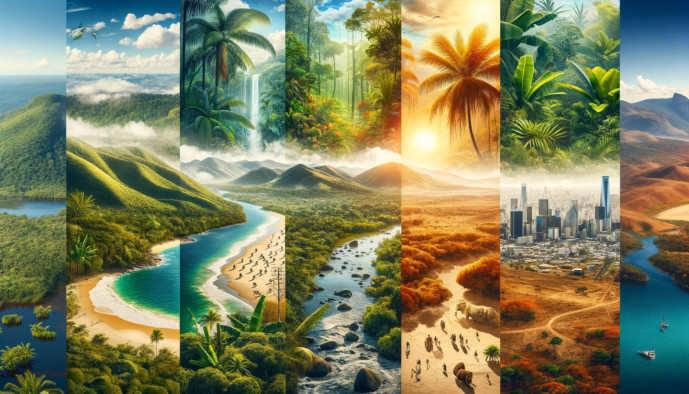Weather and Climate in Brazil
Explore Brazil's diverse climates, from Amazon rainforest to arid backlands.

Essentials
Weather and Climate in Brazil
Understanding Brazil’s Seasons
As Brazil is located in the Southern Hemisphere, its seasons are the reverse of what you may be accustomed to in North America or Europe. This simple fact is key to planning your activities and packing appropriately.
- Summer: December to March
- Autumn: April to June
- Winter: July to September
- Spring: October to December
It is crucial to understand that Brazil’s immense size means there is no single national climate. Seasonal changes manifest dramatically across different regions. A winter day in the humid Amazon, for instance, bears no resemblance to a crisp winter morning in the southern highlands.
Regional Climate Breakdown
To best prepare for your journey, consider the specific climate of the regions you will be visiting. Below is a detailed guide.
The Amazon (North: Manaus, Belém)
- Climate Type: The Amazon basin has a classic equatorial climate, characterized by high heat and humidity throughout the year.
- Dry Season (July – December): This period sees significantly less rainfall, causing river levels to recede. It is generally considered the preferred time for jungle trekking and observing wildlife on the exposed riverbanks.
- Wet Season (January – June): Marked by frequent and heavy rainfall, this season transforms the landscape. The rivers swell, flooding vast areas of the forest and creating the igapós (flooded forests), which are best explored by canoe.
- Temperatures: Expect consistent heat, with daily temperatures typically ranging from 26-33°C (79-91°F) year-round.
The Northeast (Salvador, Recife, Fortaleza)
- Climate Type: This region enjoys a hot, tropical climate all year, with a more defined rainy season along the coast.
- Coastal Weather: The coast is blessed with warm temperatures and pleasant ocean breezes. The primary rainy season runs from April to July, though the rain often arrives in powerful, short-lived bursts, rarely disrupting an entire day.
- Inland (Sertão): The interior is a semi-arid region, known for being very hot and dry for much of the year. Its rainy season is short and can be unreliable.
- Temperatures: There is very little seasonal temperature variation, with averages holding steady between 25-30°C (77-86°F).
The Southeast (Rio de Janeiro, São Paulo, Minas Gerais)
- Climate Type: The climate transitions from tropical on the coast to subtropical inland and at higher elevations.
- Summer (Dec – Mar): This season is hot, humid, and receives the most rainfall. In cities like Rio de Janeiro and São Paulo, expect daily temperatures of 24-32°C (75-90°F), often accompanied by afternoon thunderstorms that provide a brief respite from the heat.
- Winter (Jun – Sep): Winter offers milder and significantly drier conditions. Days are typically sunny and very pleasant, with cooler evenings. Temperatures generally range from 18-25°C (64-77°F). Be aware that mountainous areas can experience much colder temperatures.
The Pantanal (Central-West)
- Climate Type: The world’s largest tropical wetland has a savanna climate, where the stark contrast between the wet and dry seasons dictates the rhythm of life and the entire wildlife viewing experience.
- Dry Season (April – September): This is unequivocally the best time for spotting wildlife. As the floodwaters recede, animals such as capybaras, caimans, and jaguars congregate around the remaining water sources, making them easier to observe. Days are hot and nights can be surprisingly cool.
- Wet Season (October – March): The landscape is transformed by heavy rains that flood the vast plains. While beautiful, the wildlife becomes more dispersed and harder to find. The weather is hot and very humid.
The South (Florianópolis, Porto Alegre, Iguazu Falls)
- Climate Type: This region has a subtropical to temperate climate and is the only part of Brazil to experience four distinct seasons, including a true winter.
- Summer (Dec – Mar): Summers are hot and humid, much like the Southeast, making this a popular time for visiting the beaches of Santa Catarina.
- Winter (Jun – Sep): Winters are cool to cold. In coastal areas, temperatures may be mild, but inland and at higher elevations, they can drop to 5-15°C (41-59°F). Frost is common, and light snow is not unheard of in the highest mountain towns.
- Iguazu Falls: This microclimate is hot and humid year-round. The falls are at their most powerful during the summer rains (Dec-Feb) due to the high river flow. Conversely, the lower water levels of winter (Jun-Aug) can sometimes result in clearer, more defined views of the individual cascades.
Practical Packing Advice Based on Weather
While this guide provides a solid overview, we strongly recommend checking a detailed weather forecast for your specific destinations just before you depart. This will help you make final adjustments to your packing list.
Year-Round Essentials for Most Regions
- Lightweight, breathable clothing made from natural fabrics like cotton or linen.
- High-SPF sunscreen; the equatorial and tropical sun is deceptively strong.
- A quality pair of sunglasses and a wide-brimmed hat for sun protection.
- An effective insect repellent, particularly crucial for visits to the Amazon and Pantanal.
- A light waterproof jacket or a simple poncho for sudden, unexpected downpours.
Region-Specific Additions
- For the South (Winter): Be sure to pack in layers. Include sweaters or fleece, a warm jacket, and long trousers for the cool days and cold evenings.
- For the Amazon & Pantanal: Pack lightweight long-sleeved shirts and trousers to protect against both the sun and insects. Sturdy, waterproof hiking boots are essential, and clothing made from moisture-wicking fabrics will provide the most comfort.
- For Rio & the Coast: Your focus should be on swimwear, shorts, t-shirts, and sandals. However, always include a light sweater or wrap for aggressively air-conditioned restaurants and shops, or for cooler seaside evenings.